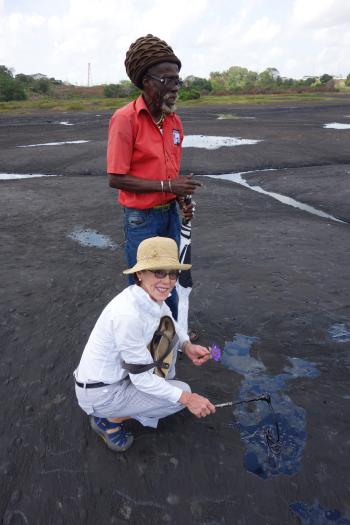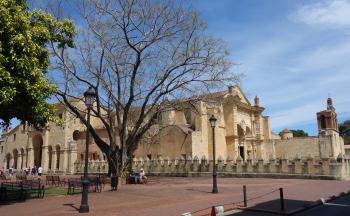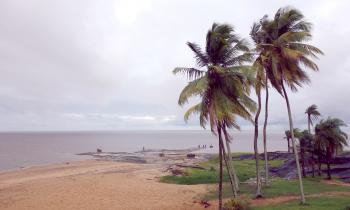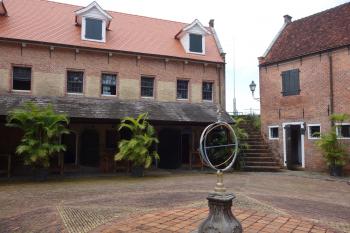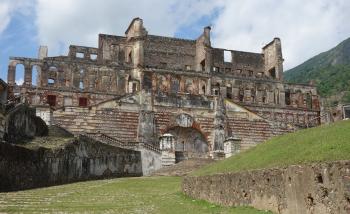Exploring the northeastern coast of South America plus the Caribbean
This article appears on page 32 of the July 2019 issue.
Rain, heat and humidity were constant companions for my wife, Iris, and me on our May 2018 trip to Trinidad & Tobago, Suriname, French Guiana, Haiti and the Dominican Republic.
Wilderness Explorers (phone 202/630-7698 from the US, wilderness-explorers.com) in Georgetown, Guyana, organized the Trinidad, Suriname and French Guiana portion of our trip, and Voyages Lumière (phone +00 509 3607 1321, voyageslumiere.com) of Port-au-Prince organized visits to Haiti and the Dominican Republic. Ilene Koenig of Let’s Travel! in Santa Monica, California (800/458-7477, www.letstravel-sm.com), coordinated the providers and arranged our international flights. The total cost for our 19-day trip was $8,739 per person, without the airfare.
We needed visas only for Suriname and Haiti, which we obtained on arrival for $40 and $10 per person (cash), respectively. A malaria prophylactic was necessary for the South American part of the trip, and Suriname made us show a yellow fever-vaccination certificate.
Trinidad & Tobago
We arrived in Port of Spain, Trinidad & Tobago, in the late evening and immediately went to our accommodations, the Kapok Hotel. About 13 miles from the airport, the hotel is located near the Queen’s Park Savannah, and there were nice views of Port of Spain from the hotel’s main restaurant.
The hotel’s lobby restaurant, Kava, stayed open late, so on the first night we were able to get a pizza and cold beer to end the evening. (The next night, we had a good Chinese dinner at Tiki Village, on the eighth floor.)
Our Port of Spain tour included the Houses of Parliament, Queen’s Park Savannah, the Magnificent Seven (elegant late-19th-century and early-20th-century gingerbread-style mansions) and a panoramic view of Port of Spain from the surrounding hills. We then went to the Caroni Marsh to see the mangrove forests (with small boa constrictors in the trees) and a wide variety of birds, including pink flamingos and — the highlight — a flight of scarlet ibises returning at dusk to their roosts.
On our way to the marsh, we traveled east of Port of Spain to St. Augustine to see the oldest (early 20th century) Benedictine monastery in the Caribbean, located nearly 700 feet above St. Augustine. Many children were there getting blessings from the brothers for the next day’s important school-choice examinations.
On to Suriname
Following another day of touring in Trinidad, we were scheduled to take a Suriname Airways flight to Paramaribo, Suriname, but it was canceled, so we had to fly through Georgetown, Guyana, delaying our arrival in Paramaribo till about 3 a.m. Oh, the joys of air travel when there are few options!
From the airport, we were transferred to our hotel, the Torarica Hotel & Casino, on the banks of the Suriname River and near the city center.
We had an all-day tour the next day of Paramaribo, a UNESCO World Heritage Site, and the surrounding area. After a look at the main sights, including the central market and the Roman Catholic Saint Peter and Paul Cathedral (the largest wooden structure in South America, with a great organ), we visited Paramaribo’s posh residential area to the north, marveling at some of the garish homes occupied by the city’s elite.
We then traveled east of Paramaribo, across a new 2-lane bridge, to visit Peperpot Nature Park, a former plantation for coffee and cocoa. We took a nature walk on the old plantation, which, after 40 years, has returned to secondary forest.
East of Paramaribo, we visited Fort Nieuw-Amsterdam, at the confluence of the Commewijne and Suriname rivers, where a few World War II artillery pieces still point out to the sea.
From the fort’s dock, we caught a small boat to cross the Commewijne River, enjoying some sunset dolphin viewing before returning to Paramaribo.
Into the jungle
Our journey continued with a 90-minute flight in a 6-seat plane to Kabalebo Nature Resort. The landing on the short, grass runway there was a breeze for our experienced pilot.
The resort is located in western Suriname, toward Guyana, in an area of the Amazon jungle that is largely uninhabited. Moreover, as it was the rainy season, we had the entire resort to ourselves and much of the staff was on leave.
We stayed in a Panorama Suite, which was a 5-minute walk from the main lodge and dining area and was located in its own 2-story structure with an outstanding veranda.
For our one full day there, the resort arranged a special trip downriver to see the “poisonous frogs.” We walked for six hours with our Arawak guide through the thick jungle, but we saw no frogs. We heard them, but they were elusive in the rainy forest.
We did see a racer snake, butterflies and birds and the jungle had a plethora of mushroom varieties. On the river ride back to the resort, the birds serenaded us from the thick shore foliage.
Before dinner, Armida, the chief of many things at the resort and a true naturalist, showed us a female ocelot that she had been following for about five years. She said she feeds it most nights, and the ocelot (about the size of a large house cat) lets visitors get quite close, though, based on videos we saw, this “friendly” ocelot is quite vicious to other cats that enter her territory.
In the morning, Jerry, the resort’s manager, took us to the river to show why people don’t swim there. Tossing out his baited line with some chicken pieces, he quickly caught a black piranha. With small, razor-sharp teeth, this fish (along with many others in the river) can rapidly devour the flesh of a mammal.
French Guiana
Back in Paramaribo, we headed out at 7:15 a.m. for the drive across the north of Suriname to the French Guiana border. Our trip covered a total of about 210 miles, taking us into the interior of Suriname and French Guiana and then to the coast.
We entered French Guiana by crossing the Maroni River in a canoe. Our wonderful new guide and driver met us on the other side.
After arriving in the country on May 8, we visited the impressive Camp de la Transportation in St. Laurent du Maroni, which was a transit point for prisoners before most were sent on to other prisons in the country. Alfred Dreyfus, a Jewish-French military officer famously accused of treason, and Henri Charrière (who wrote “Papillon”) were former inmates who transited through the camp.
The cells for the prisoners were grim, but the cells for those condemned to die were even worse. During the hundred or so years that the center was in operation, about 40 prisoners were executed by guillotine in the center’s courtyard for all the prisoners to see.
After our visit to the transportation center (and a fabulous lunch at La Göelette, near St. Laurent du Maroni), we continued to Kourou and Hôtel des Roches, located on a sand spit in the Kourou River at its junction with the Atlantic Ocean. Our room looked out onto a rough beach and the Iles du Salut, off the coast.
The hotel was nearly deserted because of the reduced launch schedule at the nearby Space Centre, which we toured the next day.
Founded in the 1960s, the center (aka Spaceport) is used today by the European Space Agency, the French space agency and Arianespace. Since 1964, hundreds of satellite placements have been made from there.
The tour (which is given only in French) is basically a bus ride around the massive area, with a look at the launch sites, control rooms and press facilities.
Following lunch, we went to Cayenne, the capital, for a rainy city tour. Cayenne was a pleasant, tropical town with charming, clean streets bordered by French-colonial buildings.
From Cayenne, we took an early-afternoon flight on Air France, arriving in Port-au-Prince, Haiti, at 6:20 p.m. We had one-hour layovers in Martinique and Guadeloupe, both part of the French Antilles. In Guadeloupe, we enjoyed the gastronomic delicacies of the Air France airport salon.
Haiti
After arriving in Port-au-Prince, we went directly to our boutique hotel, Villa Bambou, which overlooked the city and the bay. Villa Bambou was a real treat, and the meals and service were outstanding. The owner of Voyages Lumière (the agency used for this part of our tour), an energetic British lady named Jacqualine Labrom, met us the first evening at the villa, and we enjoyed a 3-hour dinner and discussion with this charming, longtime resident of Haiti.
A bad earthquake hit Haiti in 2010, and Port-au-Prince was still in shambles (with many “ghost” buildings) in 2018. Piles of trash could be seen in the streets of Port-au-Prince, Jacmel and Cap-Haïtien, and guards armed with rifles and shotguns were obvious at hotels, restaurants and public places.
Although there are islands of tranquility, like Villa Bambou, outstanding tourist sites, like the Sans-Souci Palace and the Citadelle, plus beautiful schoolchildren in their colorful uniforms and hair ribbons and friendly drivers and guides, there is no way to sugarcoat the physical tragedy that is Haiti and its raw tourist environment.
During our time in Haiti, we took a day trip to Jacmel, in the southeastern part of the country. Although the distance from Port-au-Prince was only about 60 miles, the conditions of the roads and the elevation gains required a worthwhile 3-hour drive through the hills and green countryside.
Jacmel is a well-known artists’ and Carnaval city. Our walk through the city was hilly and pleasant, and it was fun to view the buildings with New Orleans-style balconies and the artists’ shops.
We spent the night at Hôtel-Restaurant Cyvadier Plage, situated on a lovely bay outside of town. The spiny lobster at dinner and the sea breeze and cool pool made for an outstanding hotel stay.
Returning to Port-au-Prince the next day, we were delayed for hours on the highway by a student strike. Instructors at the area schools had not been paid in months, and the students sat on the roadway to protest the lack of pay. Since there was no other road to the city, we and hundreds of other trucks and cars were stuck!
We arrived back in Port-au-Prince so late that we skipped our planned activities and returned to Villa Bambou for dinner.
Local interaction
A brief flight took us to Cap-Haïtien in the north of the country, where we visited the World Heritage Sites of the Citadelle and the Sans-Souci Palace.
We took a long hike from Sans-Souci, once an opulent French-style palace, to the hillside location of the impressive Citadelle, which had a large collection of captured French cannons — what a job to haul those heavy cannons up the hill! — and mounds of cannonballs.
After hiking down from the fort, we had lunch at a local community restaurant and cultural center in Milot, Lakou Lakay, which was run by our guide for the day, Maurice Etienne, and his wife. As rain fell, we had a good lunch on the patio and listened to Maurice’s stories about growing up in Milot and playing in the ruins of the two now World Heritage-designated sites.
Maurice was impressed to hear that our grandson’s school had adopted a Haitian school (providing all teachers at the Haitian school with pay for a year), and Maurice asked a little boy at the cultural center to write our grandson a note of thanks — a beautiful gesture. Fortunately, our young grandson can read and understand French.
Maurice then took us to Cap-Haïtien for a city walking tour, and we enjoyed seeing the 18th- and 19th-century balconied houses, the colonial public buildings and the cathedral (which was undergoing renovation).
We stayed at Hôtel Roi Christophe, the 18th-century French Governor’s palace, situated in central Cap-Haïtien. The hotel’s gardens were nice, and dinner on the veranda was good.
We returned to Port-au-Prince in the morning, and Jacqualine Labrom met us at the airport, taking us out of town to the metal-art village of Noailles in Croix des Bouquets. Hundreds of artists have congregated in this area, and they have improved the streets, streetlights and sidewalks, creating an appealing arts district.
We visited some of Jacqualine’s favorite artists and willingly acquired metal masks, trays and wall hangings, which were light and easily carried in our luggage.
Our last evening in Haiti was spent at Villa Bambou, where we had a final great meal while looking at the lights of Port-au-Prince and the ships on the bay.
Dominican Republic
A half-hour morning flight across Hispaniola took us to Santo Domingo, Dominican Republic, and we went directly to our hotel, the centrally located Hodelpa Nicolás de Ovando, on the banks of the Ozama River and within the walls of the historic colonial city.
Our local guide, Marguerite, was personality-plus, and we enjoyed exploring Santo Domingo with her during our two days there.
Some of the city’s 16th-century structures have been restored, and others remain in their aged condition. The interiors of the Catedral Primada de América and the Alcázar de Colón are worth visiting to get a better sense of the early-16th-century lifestyle and decoration.
On our second day with Marguerite, we visited newer parts of Santo Domingo to see the Presidential Palace as well as history and cultural museums.
Dining was good in Santo Domingo, and we had dinners at Ristorante la Briciola in the Colonial Zone, and Dos Mundos, at the Nicolás de Ovando.
Leaving Santo Domingo for Los Angeles, we found our flight with JetBlue very satisfactory.

